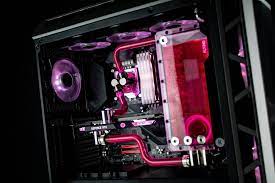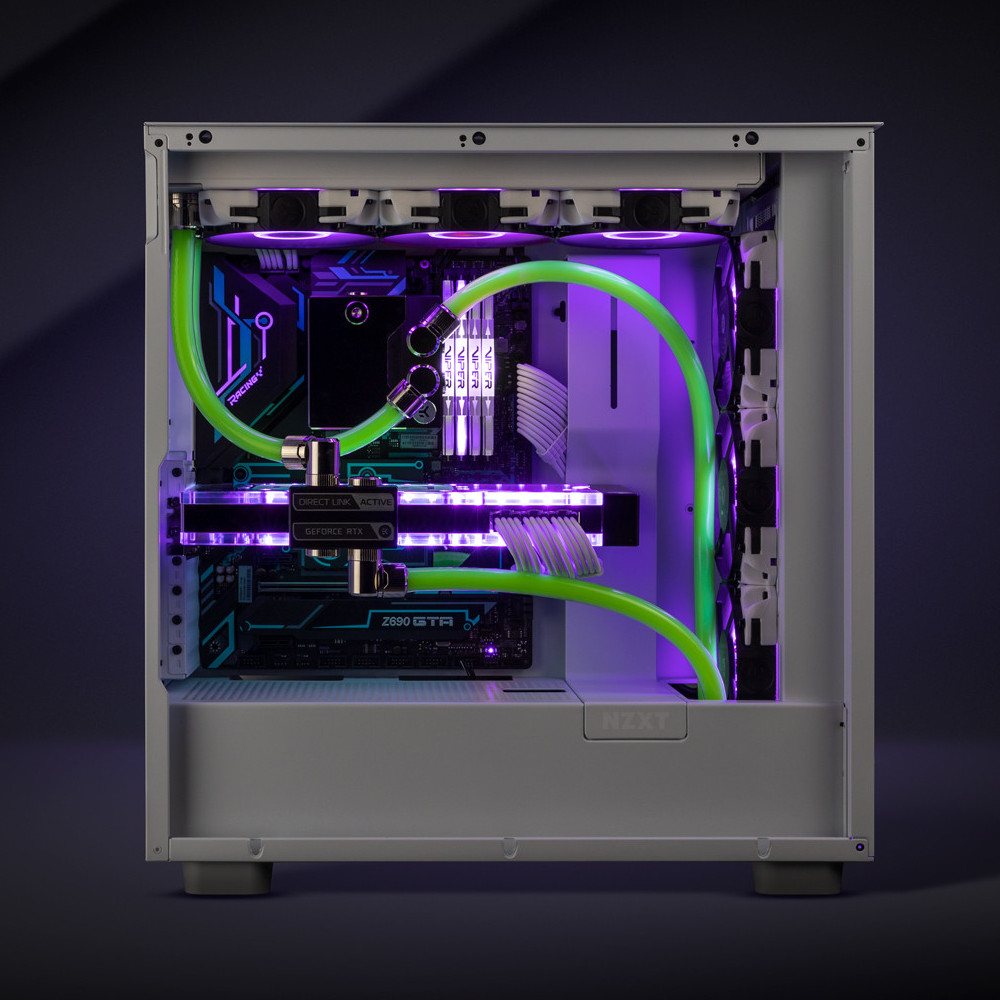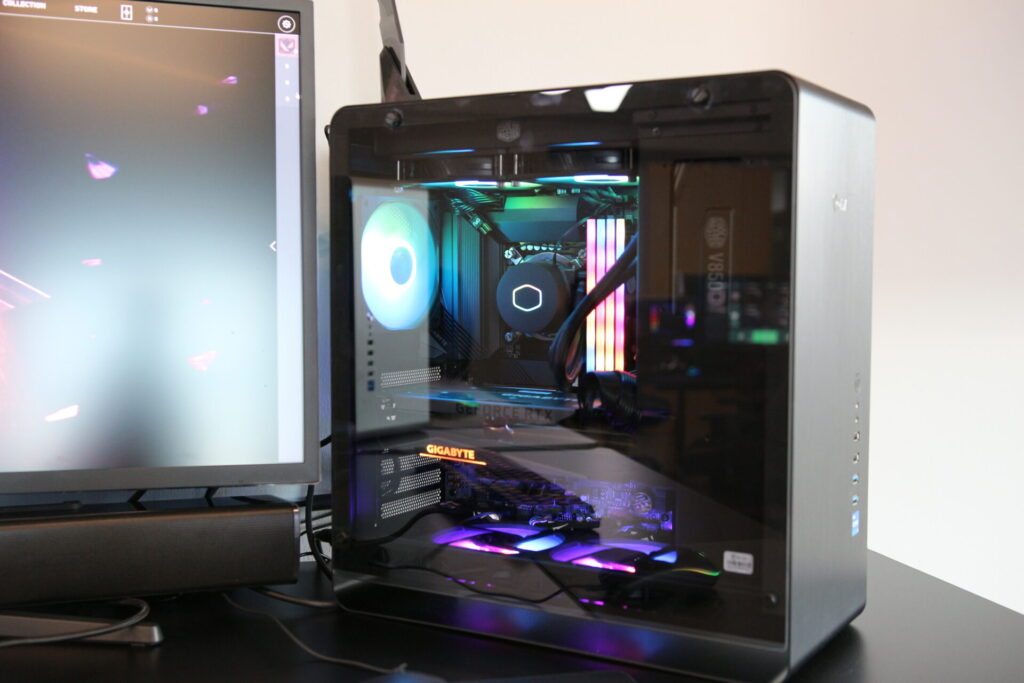Custom PC water cooling has become increasingly popular among enthusiasts and hardcore gamers who want to push their systems to the limit. It’s the ultimate way to keep your rig running cool and quiet, even when you’re putting it through its paces. But if you’re thinking about taking the plunge, you might be wondering what kind of tubing to use. Should you go with hard tubing or soft tubing?
Choosing the right tubing for your custom loop is like picking the perfect pair of shoes for a marathon. You want something that’s going to be comfortable, durable, and able to go the distance. But just like with shoes, there’s no one-size-fits-all solution. It all depends on your personal preferences, your budget, and your level of experience.
In this post, we’ll be taking a deep dive into the world of hard tubing vs. soft tubing for custom PC water cooling. We’ll cover the pros and cons of each option, and help you figure out which one is right for your build.
Here are 4 key takeaways on Hard vs. Soft tubing for Custom PC water cooling:
Hard tubing offers a clean, professional look and allows for precise bends and routing, but requires more skill, tools, and patience to work with compared to soft tubing.
Soft tubing is generally easier to work with, more affordable, and more forgiving, making it a good choice for beginners or those on a budget, but may not provide the same level of visual appeal as hard tubing.
Factors to consider when choosing between hard and soft tubing include aesthetics, budget constraints, skill level, case compatibility, and space limitations.
Tubing size matters for custom water cooling loops, as it can affect flow rate, pressure, and overall performance, with larger sizes offering better cooling but requiring more space and smaller sizes being easier to route but potentially restricting flow.
1. Hard Tubing

What is Hard Tubing?
Hard tubing is the crème de la crème of custom water cooling. It’s the kind of tubing that makes your friends do a double-take when they see your rig. But what exactly is it?
Materials
Hard tubing is typically made from rigid materials like acrylic, glass, or metal. Acrylic is the most popular choice because it’s easy to work with and comes in a variety of colors. Glass is another option, but it’s more expensive and harder to cut. Metal tubing is also available, but it’s not as common because it’s harder to bend and can be prone to corrosion.
Rigid Nature
The defining feature of hard tubing is its rigidity. Unlike soft tubing, which is flexible and can be bent into almost any shape, hard tubing is stiff and unyielding. This means that you have to carefully plan out your loop before you start cutting and bending your tubes.
Pros of Hard Tubing
So why would anyone choose hard tubing over soft tubing? There are a few key advantages that make it worth the extra effort.
Aesthetics and Customization Options
Let’s face it – hard tubing just looks cool. There’s something about those perfectly straight lines and sharp bends that just screams “high-end.” And because hard tubing is available in so many different colors and finishes, you can really make your build stand out from the crowd.
But it’s not just about looks. Hard tubing also gives you a lot more control over the layout of your loop. You can create intricate designs and routing patterns that just aren’t possible with soft tubing. Want to make your CPU block the centerpiece of your build? No problem – just run your hard tubing around it in a way that draws the eye.
Durability and Leak Resistance
Another big advantage of hard tubing is its durability. Because it’s made from rigid materials, it’s less likely to kink or collapse over time. This means that your loop will stay looking great and performing well for years to come.
Hard tubing is also more resistant to leaks than soft tubing. Because the tubes are rigid, they’re less likely to come loose from their fittings. And if you do spring a leak, it’s usually easier to spot and fix with hard tubing than with soft tubing.
Improved Flow and Thermal Performance
Finally, hard tubing can actually improve the performance of your loop. Because the tubes are rigid, they create less turbulence and resistance than soft tubing. This means that your coolant can flow more smoothly and efficiently, which can lead to better thermal performance.
Hard tubing also allows you to use larger diameter tubes than soft tubing. This means that you can move more coolant through your loop, which can further improve your thermal performance.
Cons of Hard Tubing
Of course, hard tubing isn’t perfect. There are a few drawbacks that you should be aware of before you commit to using it in your build.
Difficulty in Installation and Bending
The biggest downside of hard tubing is the difficulty of installation. Because the tubes are rigid, you have to carefully measure and cut each piece to fit your loop. And if you want to create bends or curves, you’ll need to use a heat gun or other tool to soften the tubing before you can shape it.
This process can be time-consuming and frustrating, especially if you’re new to water cooling. It’s not uncommon for beginners to go through several feet of tubing before they get everything just right.
Higher Cost Compared to Soft Tubing
Another downside of hard tubing is the cost. Because it’s made from more expensive materials and requires specialized fittings, it can be significantly more expensive than soft tubing.
If you’re on a tight budget, hard tubing might not be the best choice for your build. You can still create a great-looking loop with soft tubing, and you’ll have more money left over for other components.
Limited Flexibility in Routing
Finally, hard tubing can be less flexible than soft tubing when it comes to routing. Because the tubes are rigid, you have to be careful not to create any kinks or sharp bends that could restrict flow or cause leaks.
This means that you might have to get creative with your loop layout, especially if you’re working with a small case or tight clearances. Soft tubing, on the other hand, can be easily routed around obstacles and through tight spaces.
2. Soft Tubing
What is Soft Tubing?

Soft tubing is the tried-and-true option for custom PC water cooling. It’s been around since the early days of liquid cooling, and it’s still a popular choice today. But what exactly is it?
Materials
Soft tubing is typically made from flexible materials like PVC, rubber, or silicone. PVC is the most common choice because it’s inexpensive and easy to work with. Rubber and silicone tubing are also available, but they tend to be more expensive and can be harder to find in the sizes and colors you need.
Flexible Nature
The defining feature of soft tubing is its flexibility. Unlike hard tubing, which is rigid and unyielding, soft tubing can be bent and twisted into almost any shape. This makes it much easier to route your tubing around obstacles and through tight spaces in your case.
Pros of Soft Tubing
So why would you choose soft tubing over hard tubing? There are a few key advantages that make it a great choice for many custom PC builds.
Ease of Installation and Routing
The biggest advantage of soft tubing is its ease of installation. Because it’s flexible, you don’t have to worry about measuring and cutting each piece to fit your loop. Instead, you can simply route the tubing where you need it to go and trim it to length.
This makes soft tubing a great choice for beginners who are new to water cooling. It’s also a good option if you’re working with a small case or tight clearances, as you can easily route the tubing around obstacles and through tight spaces.
Lower Cost Compared to Hard Tubing
Another advantage of soft tubing is its lower cost. Because it’s made from less expensive materials and doesn’t require specialized fittings, it can be significantly cheaper than hard tubing.
If you’re on a tight budget, soft tubing is a great way to get into custom water cooling without breaking the bank. You can still create a great-looking loop with soft tubing, and you’ll have more money left over for other components.
Compatibility with a Wider Range of Fittings
Soft tubing is also more compatible with a wider range of fittings than hard tubing. Because it’s flexible, it can be used with a variety of different fitting types, including barbs, compression fittings, and push-fit fittings.
This means that you have more options when it comes to choosing your fittings, and you can mix and match different types to create a unique look for your build.
Cons of Soft Tubing
Of course, soft tubing isn’t perfect. There are a few drawbacks that you should be aware of before you commit to using it in your build.
Less Aesthetically Pleasing Than Hard Tubing
One of the biggest downsides of soft tubing is its appearance. Because it’s flexible and can’t be bent into perfect angles like hard tubing, it tends to look less clean and polished.
If you’re going for a sleek, modern look for your build, soft tubing might not be the best choice. Hard tubing, on the other hand, can create a much more striking and impressive look.
Potential for Kinking and Flow Restriction
Another potential issue with soft tubing is kinking. Because it’s flexible, it can easily become kinked or pinched if it’s not routed properly. This can restrict flow and reduce the efficiency of your loop.
To avoid this, you’ll need to be careful when routing your tubing and make sure that it’s not being bent too sharply or pushed against any sharp edges in your case.
Higher Risk of Leaks and Evaporation
Finally, soft tubing can be more prone to leaks and evaporation than hard tubing. Because it’s not as rigid, it can be more easily dislodged from its fittings, especially if it’s not secured properly.
Soft tubing is also more permeable than hard tubing, which means that it can allow some of your coolant to evaporate over time. This can lead to a gradual drop in coolant levels and reduced performance.
To minimize these risks, you’ll need to be diligent about checking your loop for leaks and topping off your coolant as needed. You may also want to consider using a coolant with anti-corrosion and anti-microbial properties to help prevent buildup and extend the life of your loop.
Despite these drawbacks, soft tubing remains a popular choice for many custom PC builders. Its ease of use, affordability, and compatibility with a wide range of fittings make it a great option for those who are new to water cooling or working with a tight budget.
If you do decide to go with soft tubing for your build, just be sure to take the time to plan out your loop carefully and route your tubing in a way that minimizes the risk of kinking and leaks. With a little bit of care and attention to detail, you can create a great-looking and high-performing loop that will keep your custom PC running cool and quiet for years to come.
3. Factors to Consider When Choosing Between Hard and Soft Tubing for your Custom PC
Choosing between hard and soft tubing for your custom PC water cooling loop can be a tough decision. It’s like trying to choose between a sports car and an off-road vehicle – both have their strengths and weaknesses, and the right choice depends on your specific needs and preferences.
To help you make an informed decision, let’s take a closer look at some of the key factors you should consider when choosing between hard and soft tubing.
Aesthetics and Design Preferences
One of the biggest factors to consider when choosing between hard and soft tubing is aesthetics. If you’re building a custom PC that’s meant to be a showpiece, hard tubing is probably the way to go. Its clean lines and sharp angles can create a stunning visual effect that’s sure to turn heads.
On the other hand, if you’re more concerned with functionality than form, soft tubing may be a better choice. It may not look as impressive as hard tubing, but it gets the job done and can be easier to work with in tight spaces.
Budget Constraints
Another important factor to consider is your budget. As we mentioned earlier, hard tubing tends to be more expensive than soft tubing due to the cost of materials and specialized fittings.
If you’re working with a limited budget, soft tubing may be the more practical choice. It’s generally cheaper than hard tubing, which means you can allocate more of your budget towards other components like your CPU, GPU, or motherboard.
However, if you have a bit more flexibility in your budget and want to create a truly stunning build, hard tubing may be worth the extra investment. Just be sure to factor in the cost of tools and materials like a heat gun, silicone insert, and tubing cutter.
Skill Level and Experience with Water Cooling
Your skill level and experience with water cooling is another important factor to consider when choosing between hard and soft tubing.
If you’re new to water cooling or don’t have a lot of experience with DIY projects, soft tubing may be a better choice. It’s generally easier to work with than hard tubing and doesn’t require as much precision or specialized tools.
On the other hand, if you’re an experienced builder who’s comfortable with power tools and has a steady hand, hard tubing can be a fun and rewarding challenge. Just be prepared to take your time and practice your bending techniques before you start your build.
Case Compatibility and Space Limitations
Finally, you’ll need to consider the compatibility of your tubing choice with your case and other components. Some cases may not have enough clearance for hard tubing, especially if you’re working with a smaller form factor like Mini-ITX.
Similarly, if you have a lot of components packed into a tight space, soft tubing may be a better choice as it can be easily routed around obstacles and through tight spaces.
On the other hand, if you have a larger case with plenty of room to work with, hard tubing can create a cleaner and more organized look. Just be sure to measure your clearances carefully and plan out your loop before you start cutting and bending your tubes.
At the end of the day, the choice between hard and soft tubing for your custom PC water cooling loop comes down to personal preference and your specific needs and goals for your build.
If you’re prioritizing aesthetics and have the budget and skill level to work with hard tubing, it can create a truly stunning and unique look for your build. But if you’re more concerned with functionality, ease of use, and affordability, soft tubing may be the better choice.
Whichever option you choose, just be sure to take your time, plan carefully, and have fun with the process. Building a custom water-cooled PC is a rewarding experience that can provide years of cool, quiet performance and endless opportunities for tweaking and optimization.
Conclusion
In the end, the choice between hard tubing and soft tubing for your custom PC water cooling loop is a personal one that depends on your individual needs, preferences, and goals for your build.
Hard tubing offers a clean, modern look that can really make your build stand out from the crowd. Its rigid nature allows for precise bends and angles, creating a sense of order and sophistication. Hard tubing is also generally more durable and leak-resistant than soft tubing, which can provide peace of mind for those who want a reliable, long-lasting loop.
On the other hand, soft tubing is a more flexible and forgiving option that can be easier to work with, especially for beginners. Its lower cost and compatibility with a wider range of fittings make it a great choice for those on a budget or those who want more flexibility in their loop design. Soft tubing is also a good choice for smaller cases or builds with tight clearances, as it can be easily routed around obstacles and through tight spaces.
Ultimately, the best choice for you will depend on your individual circumstances and priorities.
If you’re an experienced builder with a larger budget and a desire for a showpiece build, hard tubing may be the way to go. But if you’re new to water cooling or simply want a reliable, easy-to-maintain loop, soft tubing may be the better choice.
Whatever you choose, remember that building a custom water-cooled PC is a learning process that requires patience, attention to detail, and a willingness to experiment and try new things. Don’t be afraid to make mistakes or to ask for help when you need it – the water cooling community is full of experienced builders who are happy to share their knowledge and expertise.
So whether you choose hard tubing or soft tubing, remember to have fun with the process and enjoy the satisfaction of creating a truly unique and personalized build that reflects your individual style and personality. With the right approach and a bit of persistence, you can create a custom water-cooled PC that will provide years of cool, quiet performance and endless opportunities for tweaking and optimization.
FAQs on Custom PC Water Cooling
Q: Is soft or hard tubing better for PC?
A: The choice between soft and hard tubing for your custom PC water cooling loop ultimately depends on your personal preferences, skill level, and build goals. Soft tubing is generally easier to work with, more affordable, and more forgiving, making it a good choice for beginners or those on a budget. Hard tubing, on the other hand, offers a cleaner, more professional look and allows for more precise bends and routing, but it requires more skill, tools, and patience to work with.
Q: Can you use hard tubing fittings on soft tubing?
A: No, you cannot use hard tubing fittings on soft tubing, as they are designed specifically for the rigidity and precise tolerances of hard tubing materials. Attempting to use hard tubing fittings on soft tubing can result in leaks, poor connections, and damage to your components. Always use the appropriate fittings for your chosen tubing material to ensure a secure and leak-free loop.
Q: Is Hardline tubing worth it?
A: Whether hardline tubing is worth it for your custom PC water cooling loop depends on your priorities and goals for your build. Hardline tubing can certainly offer a stunning, professional look that can really make your build stand out, but it does require more skill, tools, and patience to work with compared to soft tubing. If you’re willing to put in the time and effort to learn how to bend and route hardline tubing properly, and you prioritize aesthetics over ease of installation, then hardline tubing can be a worthwhile investment.
Q: Does tubing size matter for PC water cooling?
A: Yes, tubing size does matter for PC water cooling, as it can affect the flow rate, pressure, and overall performance of your loop. Generally, larger tubing sizes (such as 1/2″ or 3/8″) can allow for higher flow rates and lower resistance, which can lead to better cooling performance. However, larger tubing also requires larger fittings and can be more difficult to route in tight spaces. Smaller tubing sizes (such as 1/4″) can be easier to work with and can fit into tighter spaces, but they may restrict flow and require a more powerful pump to maintain adequate pressure.
Q: How do I choose a tubing size?
A: When choosing a tubing size for your custom PC water cooling loop, consider factors such as the size and layout of your case, the components you plan to cool, the fittings and radiators you plan to use, and your desired flow rate and cooling performance. Generally, 3/8″ and 1/2″ tubing sizes are popular choices for custom water cooling loops, as they offer a good balance of flow rate, pressure, and ease of routing. However, it’s important to make sure that your tubing size is compatible with your chosen fittings, radiators, and other components, and that you have adequate space to route the tubing through your case.
Q: Does a thicker radiator cool better PC?
A: In general, a thicker radiator can provide better cooling performance for your custom PC water cooling loop, as it allows for more surface area and heat dissipation. Thicker radiators can also allow for slower fan speeds and quieter operation, as they can dissipate more heat with less airflow. However, thicker radiators also require more space and can be more difficult to fit into smaller cases or tight spaces.
If you’re ready to take your computing experience to the next level, it’s time to consider building a custom PC.
Whether you’re a gamer, content creator, or professional user, a custom-built PC can provide the power, performance, and flexibility you need to tackle even the most demanding tasks.
At Volta PC, we specialize in helping customers design and build their dream custom PCs. Our team of experienced technicians and enthusiasts are passionate about technology and dedicated to providing top-quality components and expert guidance throughout the build process.
When you choose Volta PC for your custom build, you can expect:
- Personalized consultation to understand your unique needs and preferences
- Expert component selection based on your budget, performance requirements, and aesthetic preferences
- Professional assembly and testing to ensure optimal performance and reliability
- Comprehensive support and warranty coverage for peace of mind
Whether you’re looking to build a high-end gaming rig, a powerful workstation for video editing or 3D rendering, or a sleek and stylish home office PC, Volta PC has the knowledge and expertise to bring your vision to life.
So why wait? Contact Volta PC today to schedule your personalized consultation and start building the custom PC of your dreams. Our friendly and knowledgeable staff are ready to answer your questions, provide expert recommendations, and guide you through every step of the build process.
Please note that while we specialize in custom PC builds, we do not currently offer liquid cooling services for our custom builds. However, our team can still help you select high-quality air cooling components that will keep your system running cool and quiet, even under heavy loads.
How to Check Your MSI Laptop CPU Temperature
Are you concerned about your MSI laptop’s performance? A crucial aspect to monitor is the…
How To Fix Gaming Computer Freezes When Exiting Games Windows 10
Are you tired of your gaming computer freezing just as you’re about to exit your…
How to Choose a New Gaming Laptop
When you decide to buy a new gaming laptop, it feels like you’re setting out…




